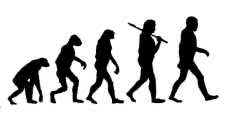Bodybuilding & Fitness: Does Survival of the Fittest Apply?

Darwin May Have Been onto Something about Body Building
Throughout human history our genetic coding has apparently developed protective mechanisms against times of famine and starvation. This "set-pointing" of
body-weight maintenance has developed to protect us from becoming underweight. Nature has seemingly provided for the human race. Traditionally we were
hunters and gatherers, with the result that the environment determined whether we would eat or not, lathe 20th century modern technology has made food
tremendously abundant and readily available. This drastic change has apparently exceeded out bodies' ability to protect us from becoming overweight.
Evolution and adaptation are processes that take eons to occur. We have not been able to adapt to the swiftness with which technology has made our lives
easier. This same technology has also afforded us a very sedentary existence. People can now spend their entire lives just sitting-sitting in the car,
sitting at the desk at work, sitting at the dinner table, and finally, sitting on the couch before retiring to lie abed. So as we are eating more, we are
also moving less. How will this development affect the future of our race?
In 1859 Charles Darwin, an English scientist studying animal species in the Galapagos Islands, observed differences in certain characteristics that gave
some animals an edge at survival and prolonging their species. One group of turtles, for example, were genetically mutated and were born with much longer
necks which enabled them to eat vegetation from small bushes that the other shorter-necked turtles could not reach. As conditions on the islands changed
and the ground vegetation was no longer sufficient to sustain the turtles, the ones with longer necks survived while their short-necked cousins died off.
Darwin called this phenomenon "natural selection" - an evolutionary process that is constantly in action. Modification of a species occurs over generations.
The human appendix is an example of evolutionary modification. Many generations ago the appendix was a digestive organ for grass and other fibrous
carbohydrates. As our bodies grew increasingly able to digest other foods, the appendix became unnecessary. Some scientists theorize that the appendix will
completely disappear in future generations.
As early humans lived their lives hunting and gathering food, they were sometimes able to amass foodstuffs and eat, sometimes unable to eat for days at a
time. The body eventually developed an enzyme called lipoprotein lipase that stored calories as fat for energy use in times of famine. If no food was
available, the fat stores would provide the necessary energy. When food was present again, the fat stores were replenished.
Today our over consumption of food is stressing our bodies with greater quantities of calories than we can process. Our bodies are engineered to store as
fat any excess calories (above the BMR and ADL). This process is the basis for the fat set-point theory, which states that each body has a certain level
of bodyweight and bodyfat that it is comfortable with. Despite sporadic attempts at weight loss through dieting or exercise, the body will always try to
regain its original set-point. That is not to say that anyone is genetically doomed to be fat - the set-point can be changed through a combination of
consistent exercise, nutrition and time. I recommend a tiered program of exercise and nutritional modification. Each tier is six months long and has been
successful in many patients. It consists of three months of calorie/fat restriction, followed by three months of strict maintenance of the new set-point
with no attempt at further change.
With our understanding of the basic genetic principles at this point, we have to wonder what the next evolutionary change will be. Darwin coined the
phrase "survival of the fittest." How ironic. Could this mean that in 2009 bodybuilders and fitness enthusiasts may pass on stronger genes and eventually
represent the human race? Think about it. Cardiovascular disease, diabetes and cancer present the greatest threats to the fall of human health and may
mimic the lack of ground vegetation on Galapagos for the turtles. Poor lifestyle habits have been implicated strongly in the development and progression
of many of these common disorders. This lifestyle weakness may mark the separation in the human species. Will bodybuilders inherit the earth? It could
happen!